Multi-Temporal Evaluation of Quantitative and Phenological Vegetation Dynamics Using Sentinel-2 Images in North Horr (Kenya)
Abstract
:1. Introduction
2. Material and Methods
2.1. Area of Study
2.2. Input Data
2.2.1. Satellite Data
- The band number 4 (b4), centered on 665 nm of wavelength and corresponding to the visible red, with a spatial resolution of 10 m;
- The band number 5 (b5), centered on 705 nm of wavelength and corresponding to the Vegetation Red Edge, with a spatial resolution of 20 m;
- The band number 8 (b8), centered on 842 nm of wavelength and corresponding to the Near Infrared, with a spatial resolution of 10 m.
2.2.2. Ground Truths
2.2.3. Meteorological Data
2.3. Methodology
2.3.1. Preliminary Ground Truths Elaboration
2.3.2. Images Pre-Processing and Vegetation Indices Calculation
- The Normalized Difference Red Edge (NDRE) index [50], which is similar to NDVI but based on the Vegetation Red Edge:
- The Canopy Chlorophyll Content Index (CCCI) [50], which is a combination of the previous two:
2.3.3. Multi-Temporal Images Creation
2.3.4. Supervised Classification
2.3.5. Outputs Surface Analysis
2.3.6. Accuracy Validation
2.3.7. Outputs Comparison with Climate Series
3. Results
3.1. ROIs Elaboration
3.2. Multitemporal Indices Classification
3.3. Vegetation Surface Analysis
3.4. Results Validation
4. Discussion
5. Conclusions
Author Contributions
Funding
Institutional Review Board Statement
Informed Consent Statement
Data Availability Statement
Acknowledgments
Conflicts of Interest
References
- UNCCD. Land Degradation Neutrality Target Setting—A Technical Guide; UNCCD: Bonn, Germany, 2016. [Google Scholar]
- Mirzabaev, A.; Wu, J.; Evans, J.; García-Oliva, F.; Hussein, I.A.G.; Iqbal, M.H.; Kimutai, J.; Knowles, T.; Meza, F.; Nedjraoui, D.; et al. Desertification. In Climate Change and Land: An IPCC Special Report on Climate Change, Desertification, Land Degradation, Sustainable Land Management, Food Security, and Greenhouse Gas Fluxes in Terrestrial Ecosystems; Shukla, P.R., Skea, J., Buendia, E.C., Masson-Delmotte, V., Pörtner, H.-O., Roberts, D.C., Zhai, P., Slade, R., Belkacemi, M., Malley, J., et al., Eds.; IPCC: Geneva, Switzerland, 2019; in press. [Google Scholar]
- Mirzabaev, A.; Nkonya, E.; Goedecke, J.; Johnson, T.; Anderson, W.; Mirzabaev, A.; Goedecke, Á.J.; Goedecke, J.; Nkonya, E.; Johnson, Á.T.; et al. Global Drivers of Land Degradation and Improvement. In Economics of Land Degradation and Improvement—A Global Assessment for Sustainable Development; Nkonya, E., Mirzabaev, A., von Braun, J., Eds.; Springer International Publishing: Cham, Switzerland, 2016; pp. 167–195. ISBN 9783319191683. [Google Scholar]
- Barbier, E.B. The economic determinants of land degradation in developing countries. Philos. Trans. R. Soc. London. Ser. B Biol. Sci. 1997, 352, 891–899. [Google Scholar] [CrossRef] [Green Version]
- Shittu, A.M.; Kehinde, M.O.; Ogunnaike, M.G.; Oyawole, F.P. Effects of Land Tenure and Property Rights on Farm Households’ Willingness to Accept Incentives to Invest in Measures to Combat Land Degradation in Nigeria. Agric. Resour. Econ. Rev. 2018, 47, 336–356. [Google Scholar] [CrossRef] [Green Version]
- Besley, T. Property rights and investment incentives: Theory and evidence from Ghana. J. Polit. Econ. 1995, 103, 903–937. [Google Scholar] [CrossRef] [Green Version]
- Kilewe, A.M.; Kealey, K.M.; Kebaara, K.K. (Eds.) The International Council for Research in Agroforestry Agroforestry Development in Kenya. In Proceedings of the Second Kenya National Seminar on Agroforestry; International Council for Research in Agroforestry: Nairobi, Kenya, 1989; p. 534. [Google Scholar]
- Perrino, E.V.; Musarella, C.M.; Magazzini, P. Management of grazing Italian river buffalo to preserve habitats defined by Directive 92/43/EEC in a protected wetland area on the Mediterranean coast: Palude Frattarolo, Apulia, Italy. Euro-Mediterr. J. Environ. Integr. 2021, 6, 1–18. [Google Scholar] [CrossRef]
- Mulinge, W.; Gicheru, P.; Murithi, F.; Maingi, P.; Kihiu, E.; Kirui, O.K.; Mirzabaev, A. Economics of land degradation and improvement in Kenya. In Economics of Land Degradation and Improvement—A Global Assessment for Sustainable Development; Nkonya, E., Mirzabaev, A., von Braun, J., Eds.; Springer International Publishing: Cham, Switzerland, 2015; pp. 471–498. ISBN 9783319191683. [Google Scholar]
- Macharia, P.N.; Ekaya, W. Vegetation degradation and its influence on rangeland of condition and trend in semi-arid Mashuru division, Kajiado district, Kenya: Oil. In Proceedings of the Soil Science Society of East Africa (SSSEA), Annual Conference, Nairobi, Kenya, 1–5 December 2003. [Google Scholar]
- Wagensommer, R.P.; Bartolucci, F.; Fiorentino, M.; Licht, W.; Peccenini, S.; Perrino, E.V.; Venanzoni, R. First record for the flora of Italy and lectotypification of the name Linum elegans (Linaceae). Phytotaxa 2017, 296, 161–170. [Google Scholar] [CrossRef]
- Xu, H.; Qiang, S.; Han, Z.; Guo, J.; Huang, Z.; Sun, H.; He, S.; Ding, H.; Wu, H.; Wan, F. The status and causes of alien species invasion in China. Biodivers. Conserv. 2006, 15, 2893–2904. [Google Scholar] [CrossRef]
- Shackleton, C.M.; Mcgarry, D.; Fourie, S.; Gambiza, J.; Shackleton, S.E.; Fabricius, C. Assessing the Effects of Invasive Alien Species on Rural Livelihoods: Case Examples and a Framework from South Africa. Hum. Ecol. 2006, 35, 1. [Google Scholar] [CrossRef]
- Jama, B.; Zeila, A. Agroforestry in the Drylands of Eastern Africa: A Call to Action; International Council for Research in Agroforestry: Nairobi, Kenya, 2005. [Google Scholar]
- Bradley, P.N. Methodology for Woodfuel Development Planning in the Kenyan Highlands. J. Biogeogr. 1988, 15, 157. [Google Scholar] [CrossRef]
- Harrison, P. The Greening of Africa: Breaking through in the Battle for Land and Food by Paul Harrison. J. Mod. Afr. Stud. 1991, 29, 336–338. [Google Scholar]
- Ng, W.-T.; Immitzer, M.; Floriansitz, M.; Vuolo, F.; Luminari, L.; Adede, C.; Wahome, R.; Atzberger, C. Mapping Prosopis spp. within the Tarach water basin, Turkana, Kenya using Sentinel-2 imagery. In Proceedings of the Remote Sensing for Agriculture, Ecosystems, and Hydrology XVIII; Neale, C.M.U., Maltese, A., Eds.; SPIE: Edinburgh, UK, 2016; Volume 9998, p. 99980L. [Google Scholar]
- Olukoye, G.A.; Kinyamario, J.I. Community participation in the rehabilitation of a sand dune environment in Kenya. L. Degrad. Dev. 2019, 20, 397–409. [Google Scholar] [CrossRef]
- Olukoye, G.; Wamicha, W.N.; van Eckert, M.; Mwanje, J.I.; Kinyamario, J.I. The place of agroforestry in the rehabilitation and utilisation of semi-desert environments of northern Kenya. In Rebuilding Africa’s Capacity for Agricultural Development—The Role of Tertiary Education; Temu, A., Chakeredza, S., Mogotsi, K., Munthali, D., Mulinge, R., Eds.; African Network for Agroforestry Education: Nairobi, Kenya, 2004; pp. 218–226. [Google Scholar]
- UN General Assembly A/RES/71/313. UN Doc. 2017, pp. 1–6. Available online: https://undocs.org/A/RES/71/313 (accessed on 12 August 2021).
- Kirui, O.K.; Mirzabaev, A.; von Braun, J. Assessment of land degradation ‘on the ground’ and from ‘above’. SN Appl. Sci. 2021, 3, 1–13. [Google Scholar] [CrossRef]
- Dubovyk, O. The role of Remote Sensing in land degradation assessments: Opportunities and challenges. Eur. J. Remote Sens. 2017, 50, 601–613. [Google Scholar] [CrossRef]
- Adole, T.; Dash, J.; Atkinson, P.M. A systematic review of vegetation phenology in Africa. Ecol. Inform. 2016, 34, 117–128. [Google Scholar] [CrossRef]
- Cheng, Y.; Vrieling, A.; Fava, F.; Meroni, M.; Marshall, M. Stella Gachoki Phenology of short vegetation cycles in a Kenyan rangeland from PlanetScope and Sentinel-2|Elsevier Enhanced Reader. Remote Sens. Environ. 2020, 248, 112004. [Google Scholar] [CrossRef]
- Muthoka, J.M.; Salakpi, E.E.; Ouko, E.; Yi, Z.-F.; Antonarakis, A.S.; Rowhani, P. Mapping Opuntia stricta in the Arid and Semi-Arid Environment of Kenya Using Sentinel-2 Imagery and Ensemble Machine Learning Classifiers. Remote Sens. 2021, 13, 1494. [Google Scholar] [CrossRef]
- Kganyago, M.; Mhangara, P.; Alexandridis, T.; Laneve, G.; Ovakoglou, G.; Mashiyi, N. Validation of sentinel-2 leaf area index (LAI) product derived from SNAP toolbox and its comparison with global LAI products in an African semi-arid agricultural landscape. Remote Sens. Lett. 2020, 11, 883–892. [Google Scholar] [CrossRef]
- Mudereri, B.T.; Dube, T.; Adel-Rahman, E.M.; Niassy, S.; Kimathi, E.; Khan, Z.; Landmann, T. A comparative analysis of PlanetScope and Sentinel-2 space-borne sensors in mapping Striga weed using Guided Regularised Random Forest classification ensemble. Int. Arch. Photogramm. Remote Sens. Spat. Inf. Sci. 2019, 42. [Google Scholar] [CrossRef] [Green Version]
- Masemola, C.; Cho, M.A.; Ramoelo, A. Sentinel-2 time series based optimal features and time window for mapping invasive Australian native Acacia species in KwaZulu Natal, South Africa. Int. J. Appl. Earth Obs. Geoinf. 2020, 93, 102207. [Google Scholar] [CrossRef]
- Rajah, P.; Odindi, J.; Mutanga, O. Evaluating the potential of freely available multispectral remotely sensed imagery in mapping American bramble (Rubus cuneifolius). S. Afr. Geogr. J. 2018, 100, 291–307. [Google Scholar] [CrossRef]
- Huete, A.; Didan, K.; Miura, T.; Rodriguez, E.P.; Gao, X.; Ferreira, L.G. Overview of the radiometric and biophysical performance of the MODIS vegetation indices. Remote Sens. Environ. 2002, 83, 195–213. [Google Scholar] [CrossRef]
- Shaban Waswa, B. Assessment of Land Degradation Patterns in Western Kenya—Implications for Restoration and Rehabilitation. Doctoral Dissertation, Universitäts-und Landesbibliothek Bonn, Bonn, Germany, 2012. [Google Scholar]
- Gichenje, H.; Muñoz-Rojas, J.; Pinto-Correia, T. Opportunities and Limitations for Achieving Land Degradation-Neutrality through the Current Land-Use Policy Framework in Kenya. Land 2019, 8, 115. [Google Scholar] [CrossRef] [Green Version]
- Gichenje, H.; Godinho, S. Establishing a land degradation neutrality national baseline through trend analysis of GIMMS NDVI Time-series. L. Degrad. Dev. 2018, 29, 2985–2997. [Google Scholar] [CrossRef]
- Ghazanfar, S.A. Saline and alkaline vegetation of NE Africa and the Arabian peninsula: An overview. In Biosaline Agriculture and Salinity Tolerance in Plants; Birkhäuser Basel: Basel, Switzerland, 2007; pp. 101–108. [Google Scholar]
- Government of Kenya Vision 2030—Development Strategy for Northern Kenya and Other Arid Lands Final; Republic of Kenya: Nairobi, Kenya, 2012.
- Vigna, I.; Bigi, V.; Pezzoli, A.; Besana, A. Comparison and Bias-Correction of Satellite-Derived Precipitation Datasets at Local Level in Northern Kenya. Sustainability 2020, 12, 2896. [Google Scholar] [CrossRef] [Green Version]
- Siciliano, G.; Bigi, V.; Vigna, I.; Comino, E.; Rosso, M.; Cristofori, E.; Demarchi, A.; Pezzoli, A. Comparison of Multiple Maximum and Minimum Temperature Datasets at Local Level: The Case Study of North Horr Sub-County, Kenya. Climate 2021, 9, 62. [Google Scholar] [CrossRef]
- Orindi, V.A.; Ochieng, A. Kenya Seed Fairs as a Drought Recovery Strategy in Kenya. In Vulnerability, Adaptation and Climate Disasters; IDSBulletin: Brighton, UK, 2005; pp. 87–102. ISBN 5826505826. [Google Scholar]
- Karanja, F.; Mutua Nairobi, F. Reducing the Impact of Environmental Emergencies Through Early Warning and Preparedness—The Case of El Niño-Southern Oscillation (ENSO); University of Nairobi: Nairobi, Kenya, 2000. [Google Scholar]
- Owiti, Z.; Ogallo, L.A.; Mutemi, J. Linkages between the Indian Ocean Dipole and East African Seasonal Rainfall Anomalies. Available online: https://www.kms.or.ke/all-articles/262-linkages-between-the-indian-ocean-dipole-and-east-african-seasonal-rainfall-anomalies.html (accessed on 10 September 2021).
- Kiflie, K.A.; Tao, L. Opposite Effects of ENSO on the Rainfall over the Northern and Equatorial Great Horn of Africa and Possible Causes. Adv. Meteorol. 2020, 2020, 9028523. [Google Scholar] [CrossRef]
- Wenhaji Ndomeni, C.; Cattani, E.; Merino, A.; Levizzani, V. An observational study of the variability of East African rainfall with respect to sea surface temperature and soil moisture. Q. J. R. Meteorol. Soc. 2018, 144, 384–404. [Google Scholar] [CrossRef] [Green Version]
- Nicholson, S.E. The predictability of rainfall over the greater horn of Africa. Part I: Prediction of seasonal rainfall. J. Hydrometeorol. 2014, 15, 1011–1027. [Google Scholar] [CrossRef]
- European Space Agency. SENTINEL-2 User Handbook; European Space Agency: Paris, France, 2013. [Google Scholar]
- Gao, L.; Wang, X.; Johnson, B.A.; Tian, Q.; Wang, Y.; Verrelst, J.; Mu, X.; Gu, X. Remote sensing algorithms for estimation of fractional vegetation cover using pure vegetation index values: A review. ISPRS J. Photogramm. Remote Sens. 2020, 159, 364–377. [Google Scholar] [CrossRef]
- Xue, J.; Su, B. Significant remote sensing vegetation indices: A review of developments and applications. J. Sens. 2017, 2017, 1353691. [Google Scholar] [CrossRef] [Green Version]
- Hersbach, H.; Bell, B.; Berrisford, P.; Biavati, G.; Horányi, A.; Muñoz Sabater, J.; Nicolas, J.; Peubey, C.; Radu, R.; Rozum, I.; et al. ERA5 Monthly Averaged Data on Single Levels from 1979 to Present. Available online: https://cds.climate.copernicus.eu/cdsapp#!/dataset/reanalysis-era5-single-levels-monthly-means?tab=overview (accessed on 18 November 2021).
- Meroni, M.; Ng, W.T.; Rembold, F.; Leonardi, U.; Atzberger, C.; Gadain, H.; Shaiye, M. Mapping Prosopis juliflora in West Somaliland with Landsat 8 Satellite Imagery and Ground Information. L. Degrad. Dev. 2017, 28, 494–506. [Google Scholar] [CrossRef]
- Wakie, T.T.; Evangelista, P.H.; Jarnevich, C.S.; Laituri, M. Mapping current and potential distribution of non-native prosopis juliflorain the Afar region of Ethiopia. PLoS ONE 2014, 9, e112854. [Google Scholar] [CrossRef]
- Barnes, E.M.; Clarke, T.R.; Richards, S.E.; Colaizzi, P.D.; Haberland, J.; Kostrzewski, M.; Waller, P.; Choi, C.; Riley, E.; Thompson, T.; et al. Coincident detection of crop water stress, nitrogen status and canopy density using ground-based multispectral data. In Proceedings of the Fifth International Conference on Precision Agriculture, Bloomington, MN, USA, 16–19 July 2000; Volume 1619, pp. 1–15. [Google Scholar]
- Stehman, S.V. Sampling designs for accuracy assessment of land cover. Int. J. Remote Sens. 2009, 30, 5243–5272. [Google Scholar] [CrossRef]
- Foody, G.M. Status of land cover classification accuracy assessment. Remote Sens. Environ. 2002, 80, 185–201. [Google Scholar] [CrossRef]
- Lewis, H.G.; Brown, M. A generalized confusion matrix for assessing area estimates from remotely sensed data. Int. J. Remote Sens. 2001, 22, 3223–3235. [Google Scholar] [CrossRef]
- Bai, Y.; Feng, M.; Jiang, H.; Wang, J.; Liu, Y. Validation of Land Cover Maps in China Using a Sampling-Based Labeling Approach. Remote Sens. 2015, 7, 10589–10606. [Google Scholar] [CrossRef] [Green Version]
- Story, M.; Congalton, R.G. Accuracy Assessment: A User’s Perspective. Photogramm. Eng. Remote Sens. 1986, 52, 397–399. [Google Scholar]
- Czaplewski, R.L. Chapter 5: Accuracy assessment of maps of forest condition: Statistical design and methodological considerations. In Remote Sensing of Forest Environments; Springer: Boston, MA, USA, 2003; pp. 115–140. [Google Scholar]
- Congalton, R.G. A review of assessing the accuracy of classifications of remotely sensed data. Remote Sens. Environ. 1991, 37, 35–46. [Google Scholar] [CrossRef]
- Anderson, J.R.; Hardy, E.E.; Roach, J.T.; Witmer, R.E. A Land Use and Land Cover Classification System for Use With Remote Sensor Data; US Government Printing Office: Washington, DC, USA, 1976; Volume 964.
- Herrmann, S.M.; Anyamba, A.; Tucker, C.J. Recent trends in vegetation dynamics in the African Sahel and their relationship to climate. Glob. Environ. Chang. 2005, 15, 394–404. [Google Scholar] [CrossRef]
- Archibald, S.; Scholes, R.J. Leaf green-up in a semi-arid African savanna-separating tree and grass responses to environmental cues. J. Veg. Sci. 2007, 18, 583–594. [Google Scholar]
- Kenya Meteorological Department. The Weather Outlook for the June-July-August (JJA) 2021 Season and the Rainfall Performance during the March-April-May (MAM) 2021 “Long Rains” Season; Kenya Meteorological Department: Nairobi, Kenya, 2021.
- Hazard, B.; Adongo, C.; Wario, A.; Ledant, M.; Hazard, B.; Adongo, C.; Wario, A.; Ledant, M. Comprehensive Study of Pastoral Livelihoods, WASH and Natural Resource Managment in Northern Marsabit. Doctoral Dissertation, IFRA, Nairobi, Kenya, 2018. [Google Scholar]
- Rogers, P.; Nunan, F.; Fentie, A.A. Reimagining invasions: The social and cultural impacts of Prosopis on pastoralists in southern Afar, Ethiopia. Pastoralism 2017, 7, 1–13. [Google Scholar] [CrossRef] [Green Version]
- Shiferaw, W.; Demissew, S.; Bekele, T. Invasive alien plant species in Ethiopia: Ecological impacts on biodiversity a review paper. Int. J. Mol. Biol. 2018, 3, 171–178. [Google Scholar] [CrossRef] [Green Version]
- Shiferaw, H.; Schaffner, U.; Bewket, W.; Alamirew, T.; Zeleke, G.; Teketay, D.; Eckert, S. Modelling the current fractional cover of an invasive alien plant and drivers of its invasion in a dryland ecosystem. Sci. Rep. 2019, 9, 1–12. [Google Scholar] [CrossRef] [Green Version]
- Sintayehu, D.W.; Dalle, G.; Bobasa, A.F. Impacts of climate change on current and future invasion of Prosopis juliflora in Ethiopia: Environmental and socio-economic implications. Heliyon 2020, 6, e04596. [Google Scholar] [CrossRef] [PubMed]
- Maundu, P.; Kibet, S.; Morimoto, Y.; Imbumi, M.; Adeka, R. Impact of prosopis juliflora on kenya’s semi-arid and arid ecosystems and local livelihoods. Biodiversity 2009, 10, 33–50. [Google Scholar] [CrossRef]
- Masakha, E.J.; Wegulo, F.N. Impacts of Prosopis Juliflora on Land Use and Ecology of Salabani Location, Marigat District, Baringo County, Kenya. J. Environ. Earth Sci. 2015, 5, 17–23. [Google Scholar]
- Mbaabu, P.R.; Ng, W.T.; Schaffner, U.; Gichaba, M.; Olago, D.; Choge, S.; Oriaso, S.; Eckert, S. Spatial evolution of prosopis invasion and its effects on LULC and livelihoods in Baringo, Kenya. Remote Sens. 2019, 11, 1217. [Google Scholar] [CrossRef] [Green Version]
- Forestry, M.E. Prosopis Juliflora (Mathenge) and Its Genesis in Kenya. Available online: http://www.environment.go.ke/?p=5344 (accessed on 6 October 2021).
- Huho, J.M.; Omar, M.H. Prosopis Juliflora In Asals Of Kenya: A Friend Or A Foe Plant? Int. J. Sci. Res. Publ. 2020, 10, 9968. [Google Scholar] [CrossRef]
- IPC. Kenya ASAL—IPC Acute Food Insecurity and Acute Malnutrition Analysis; IPC: Nairobi, Kenya, 2021. [Google Scholar]
- County Government of Marsabit. Second County Integrated Development Plan 2018–2022; County Government of Marsabit: Marsabit, Kenya, 2018.
- Ouko, E.; Omondi, S.; Mugo, R.; Wahome, A.; Kasera, K.; Nkurunziza, E.; Kiema, J.; Flores, A.; Adams, E.C.; Kuraru, S.; et al. Modeling Invasive Plant Species in Kenya’s Northern Rangelands. Front. Environ. Sci. 2020, 8, 69. [Google Scholar] [CrossRef]
- Saha, M.V.; Scanlon, T.M.; Odorico, P.D. Examining the linkage between shrub encroachment and recent greening in water-limited southern Africa. Ecosphere 2015, 6, 1–16. [Google Scholar] [CrossRef] [Green Version]
- Herrmann, S.M.; Tappan, G.G. Vegetation impoverishment despite greening: A case study from central Senegal. J. Arid Environ. 2013, 90, 55–66. [Google Scholar] [CrossRef]
- Ibrahim, Y.Z.; Balzter, H.; Kaduk, J. Land degradation continues despite greening in the Nigeria-Niger border region. Glob. Ecol. Conserv. 2018, 16, e00505. [Google Scholar] [CrossRef]
- Zhang, Z.; Zhang, B.; Zhang, X.; Yang, X.; Shi, Z.; Liu, Y. Grazing altered the pattern of woody plants and shrub encroachment in a temperate savanna ecosystem. Int. J. Environ. Res. Public Health 2019, 16, 330. [Google Scholar] [CrossRef] [Green Version]
- Bazgir, M.; Omidipour, R.; Heydari, M.; Zainali, N.; Hamidi, M.; Dey, D.C. Prioritizing woody species for the rehabilitation of arid lands in western Iran based on soil properties and carbon sequestration. J. Arid. Land 2020, 12, 640–652. [Google Scholar] [CrossRef]
- Dougill, A.J.; Fraser, E.D.G.; Reed, M. Anticipating Vulnerability to Climate Change in Dryland Pastoral Systems: Using Dynamic Systems Models for the Kalahari. Ecol. Soc. 2010, 15, 17. [Google Scholar] [CrossRef] [Green Version]
- Reid, R.S.; Gachimbi, L.N.; Worden, J.; Wangui, E.E.; Mathai, S.; Mugatha, S.M.; Campbell, D.; Maitima, J.M.; Butt, B.; Gichohi, H.; et al. Linkages between Changes in Land Use, Biodiversity and Land Degradation in the Loitokitok Area of Kenya; LUCID: Nairobi, Kenya, 2004. [Google Scholar]
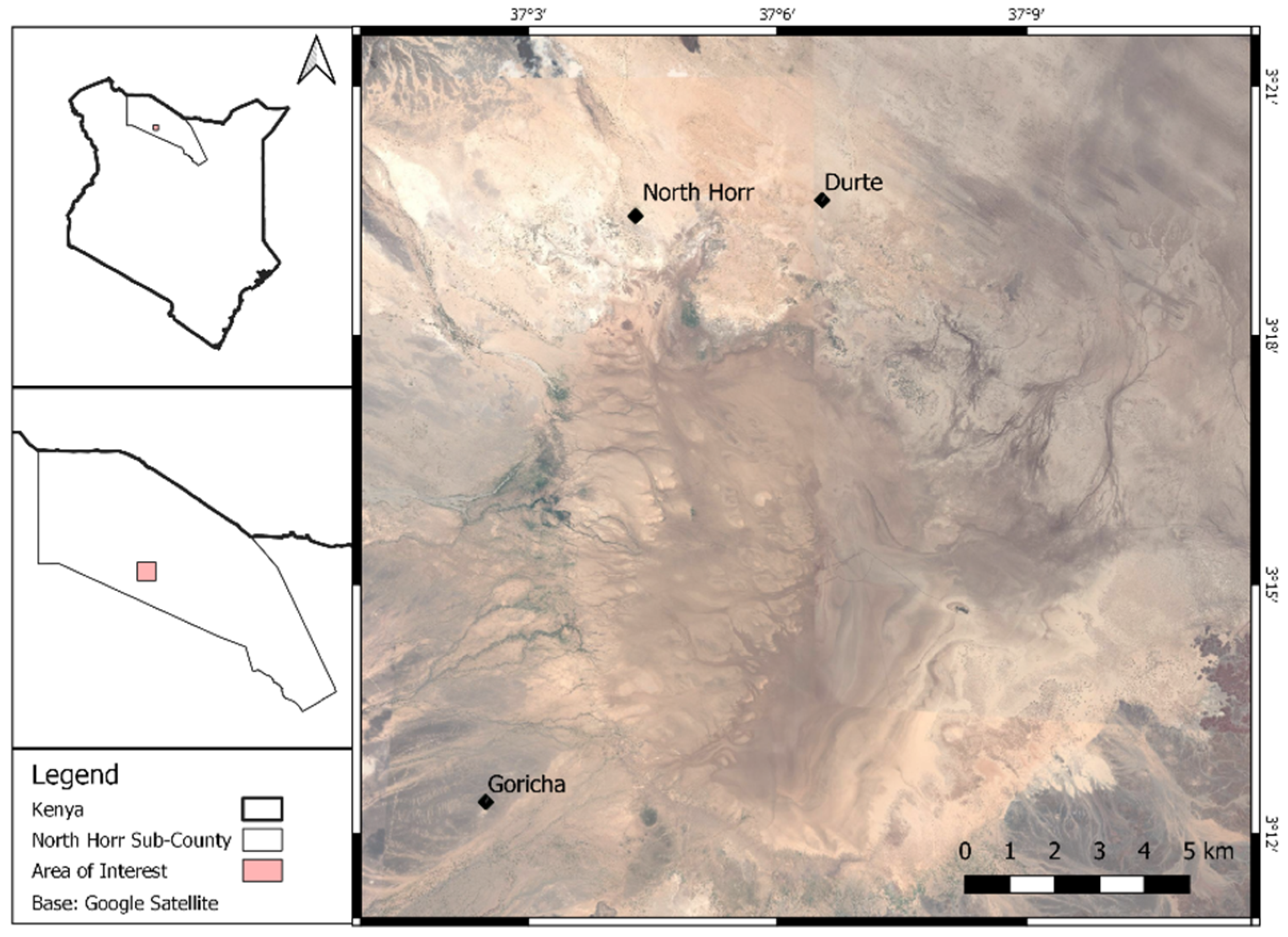
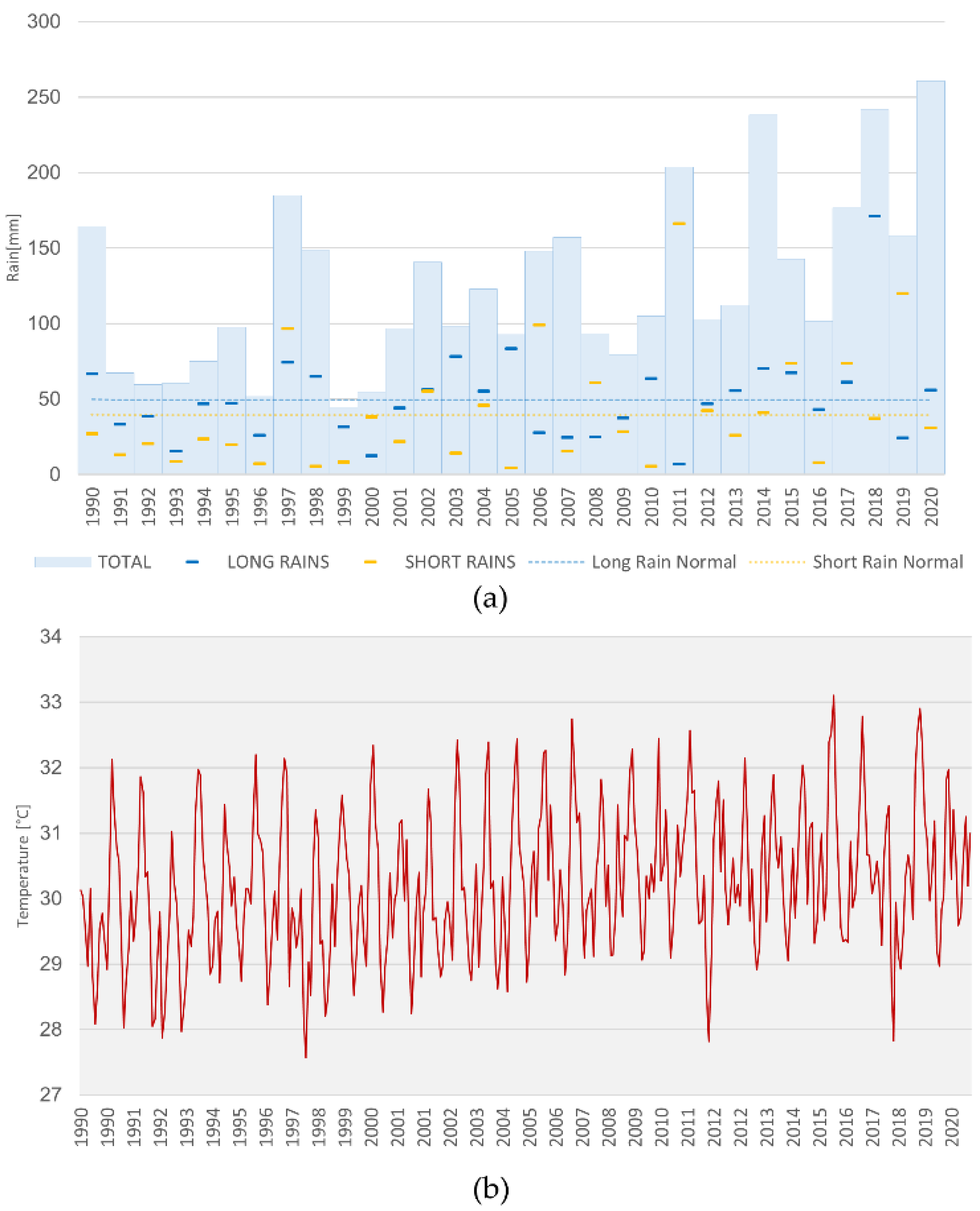
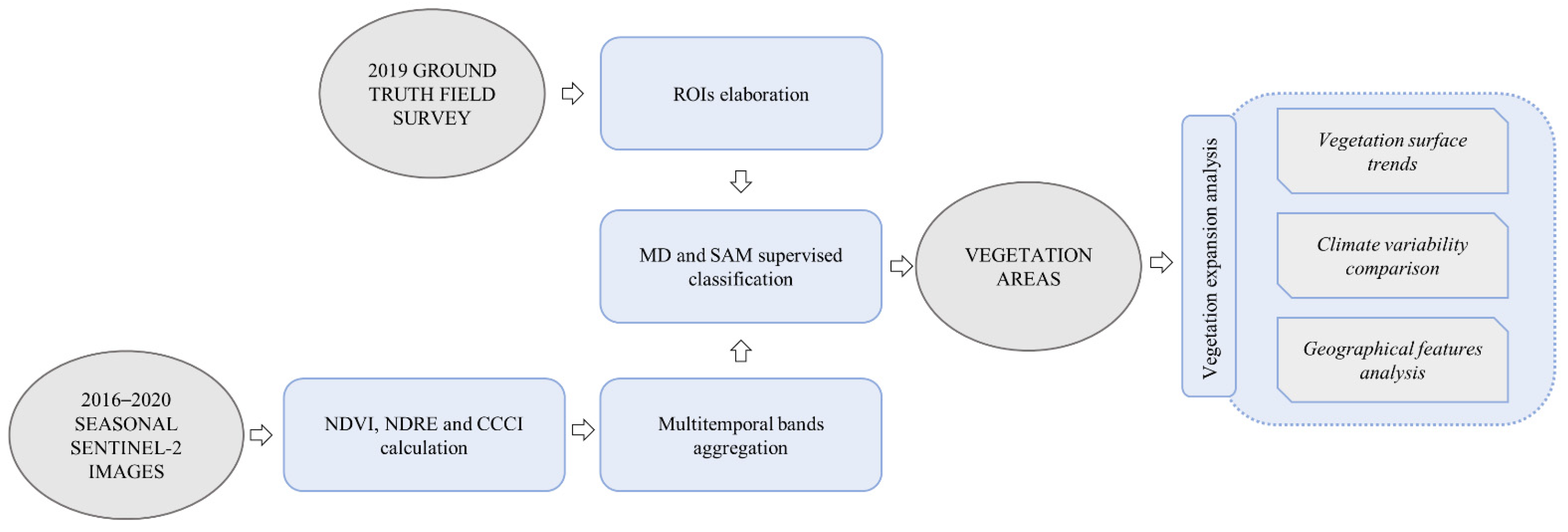
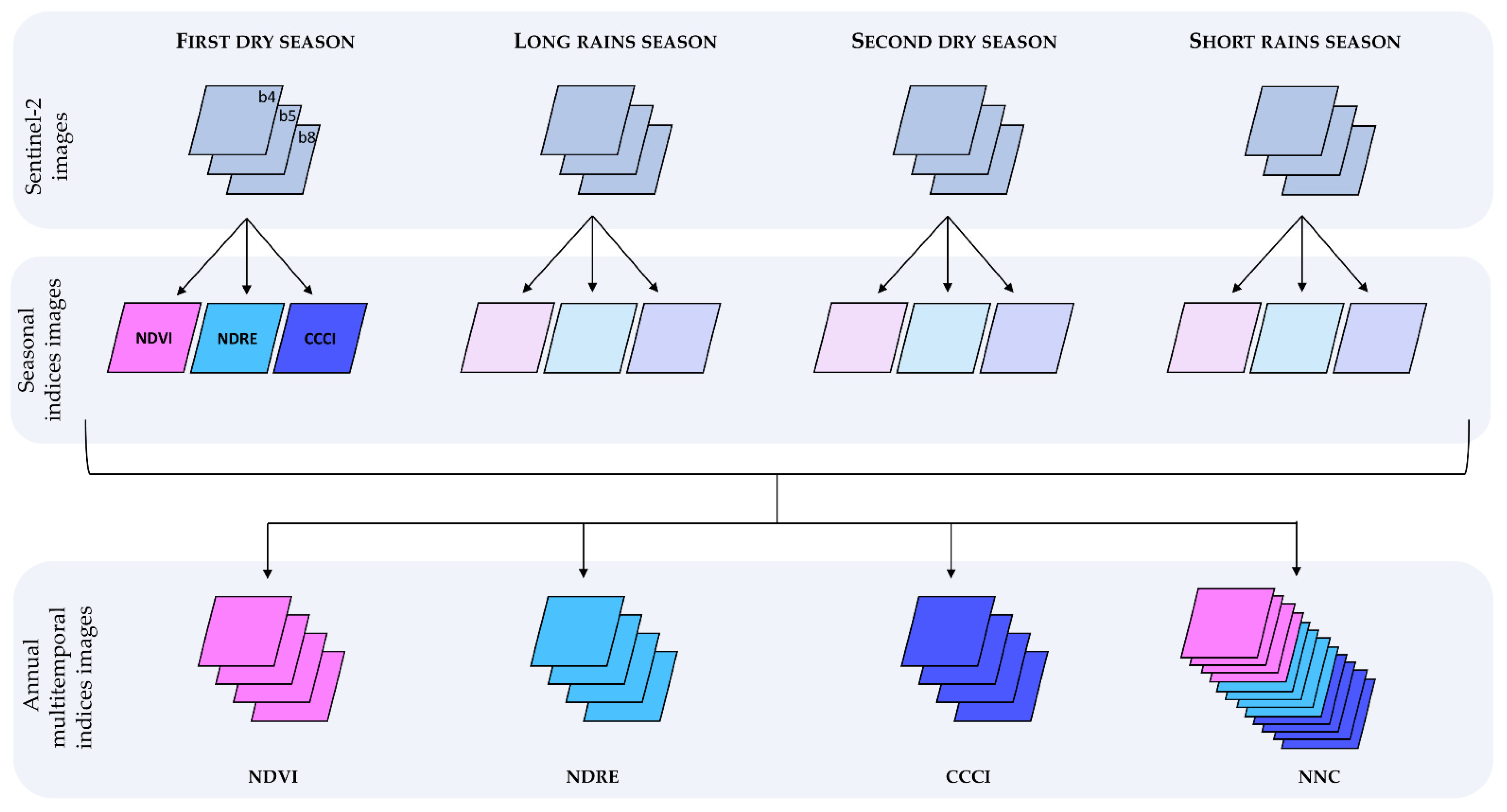
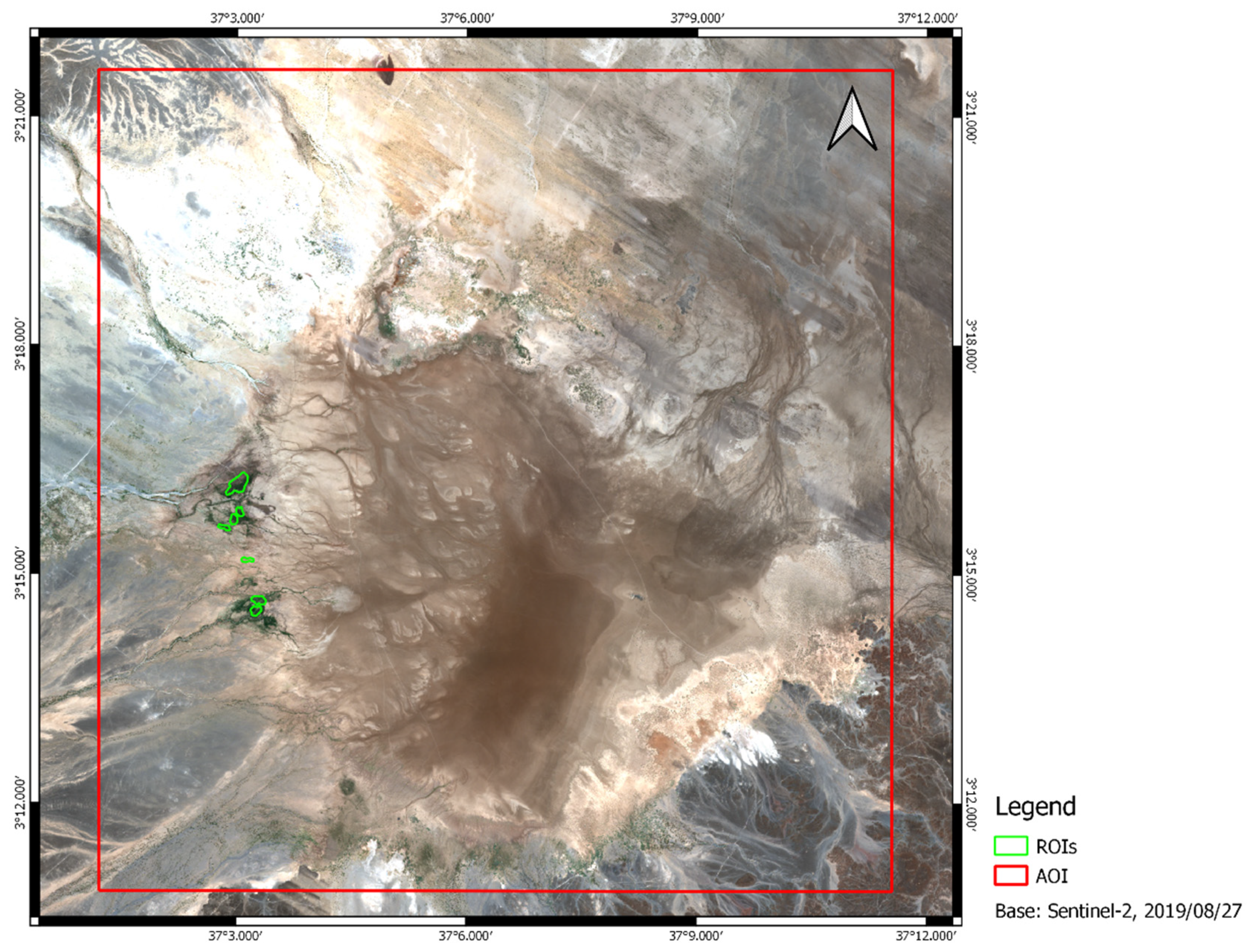
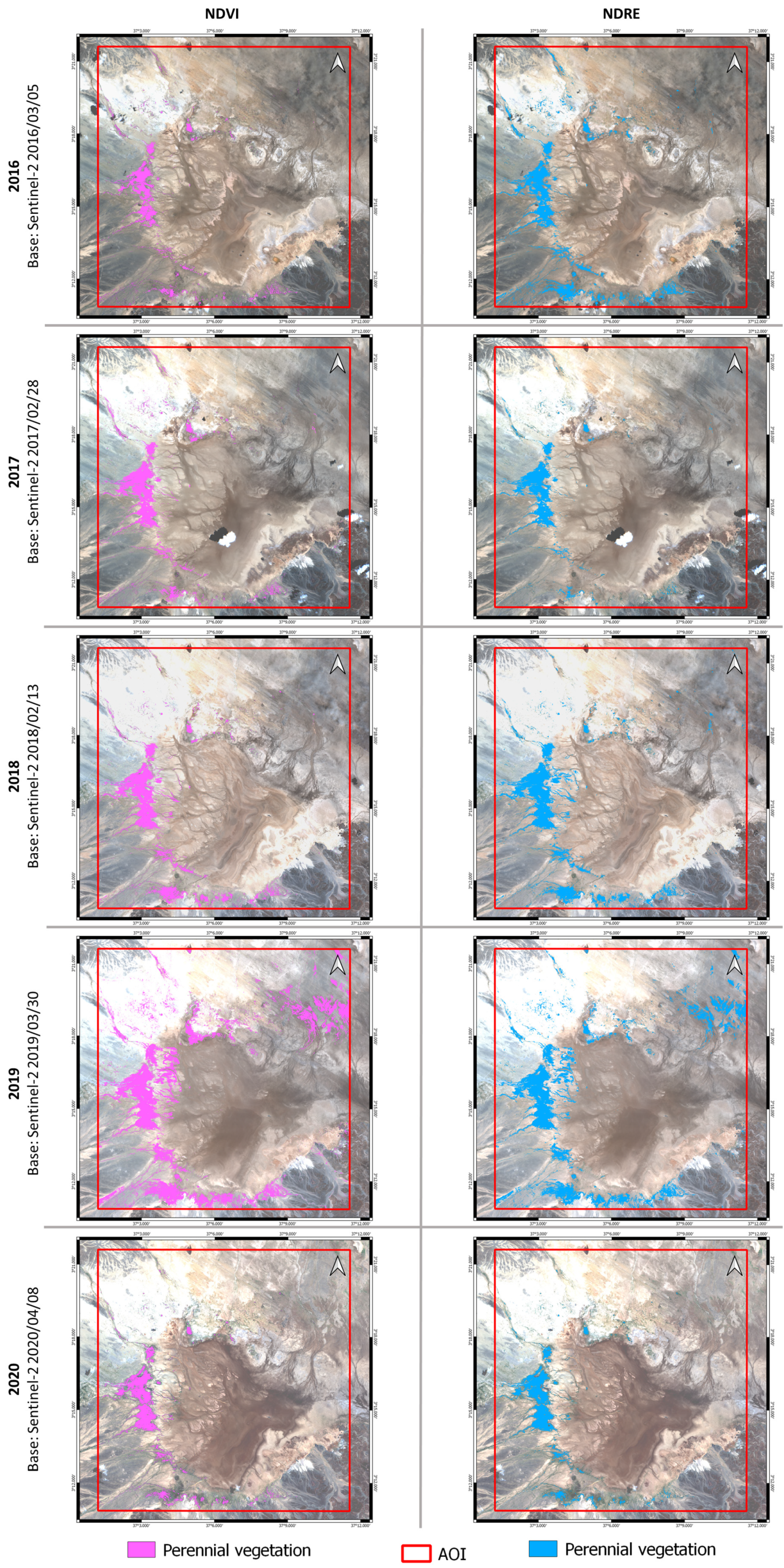
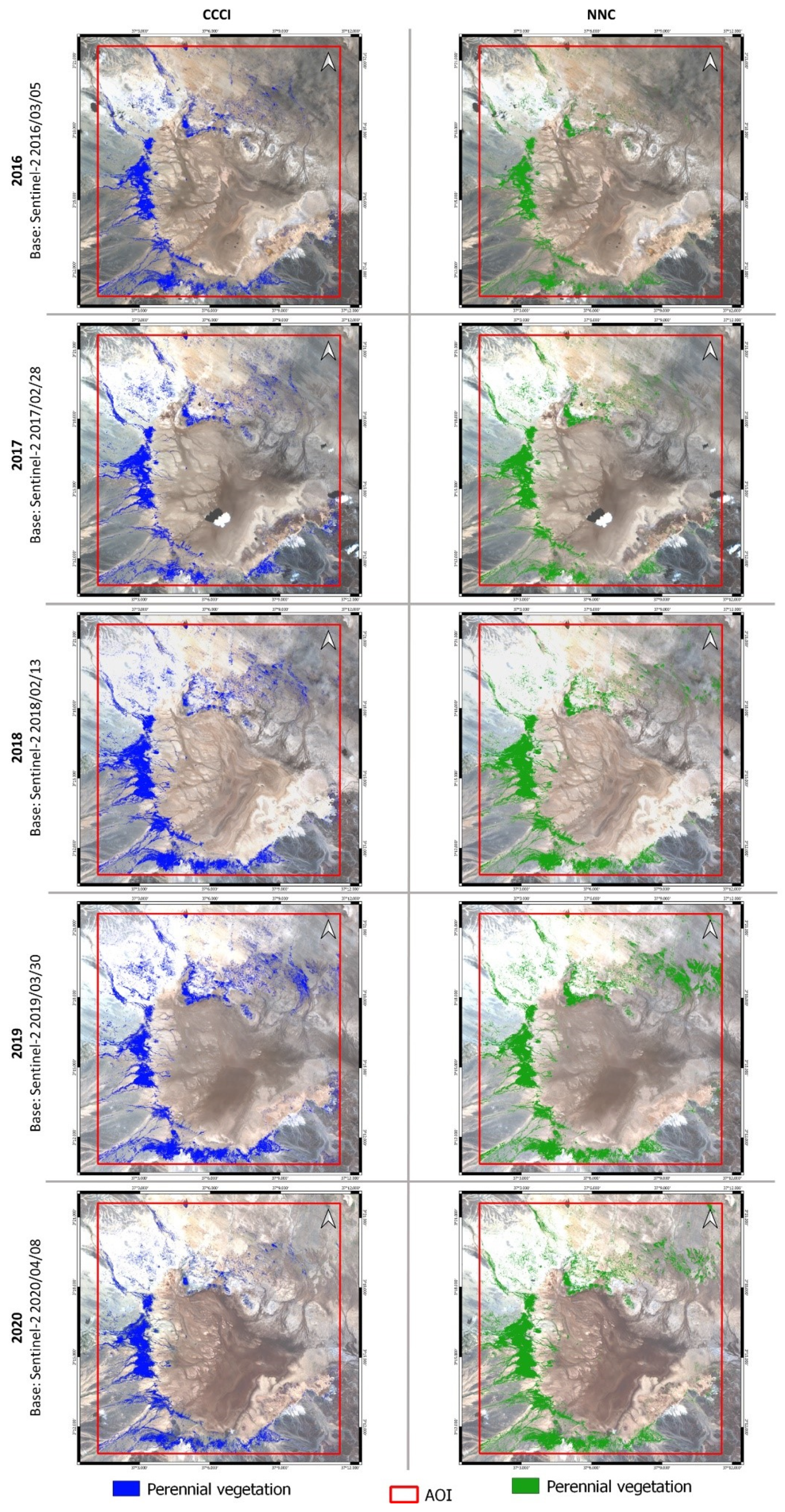
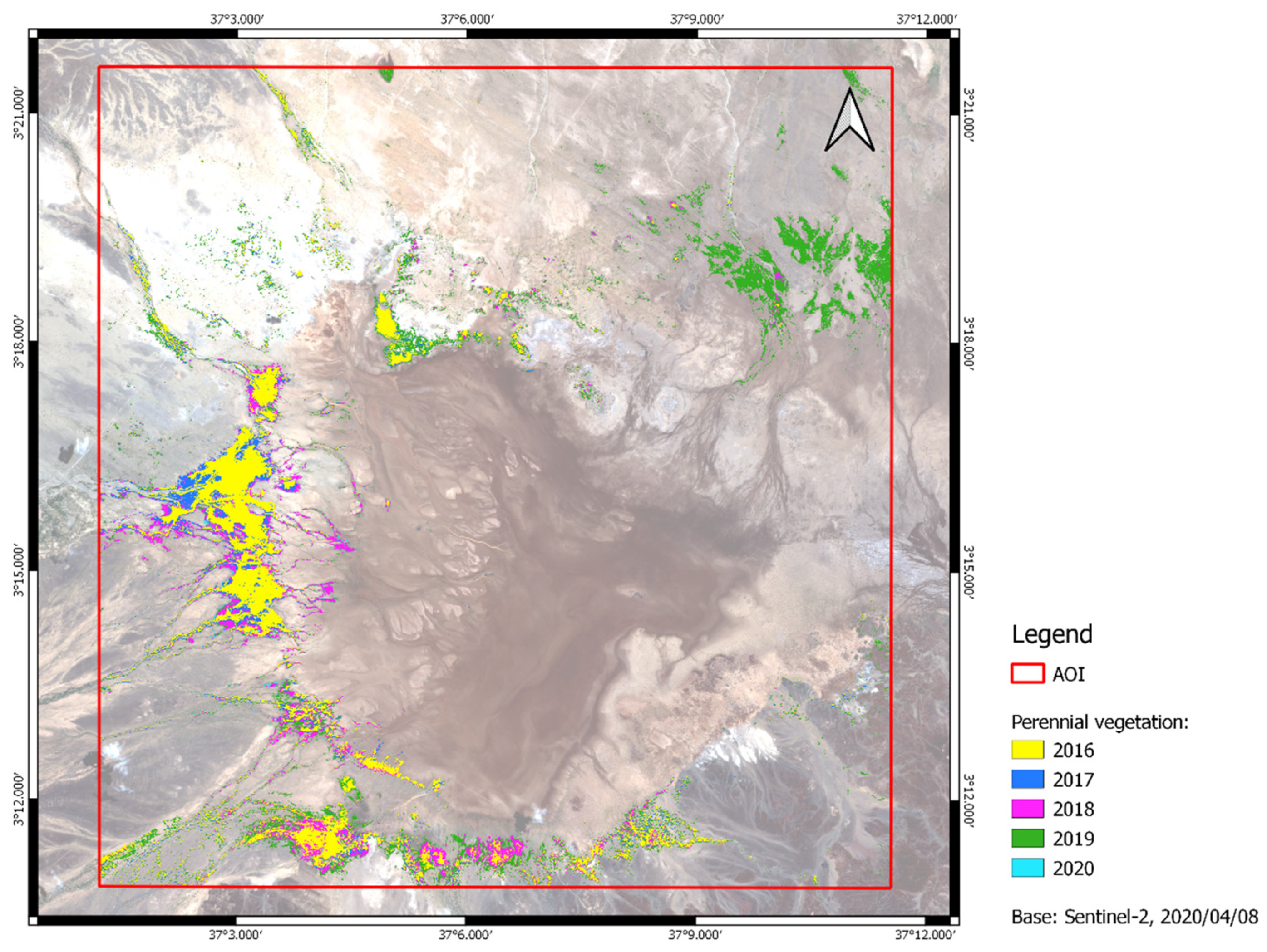
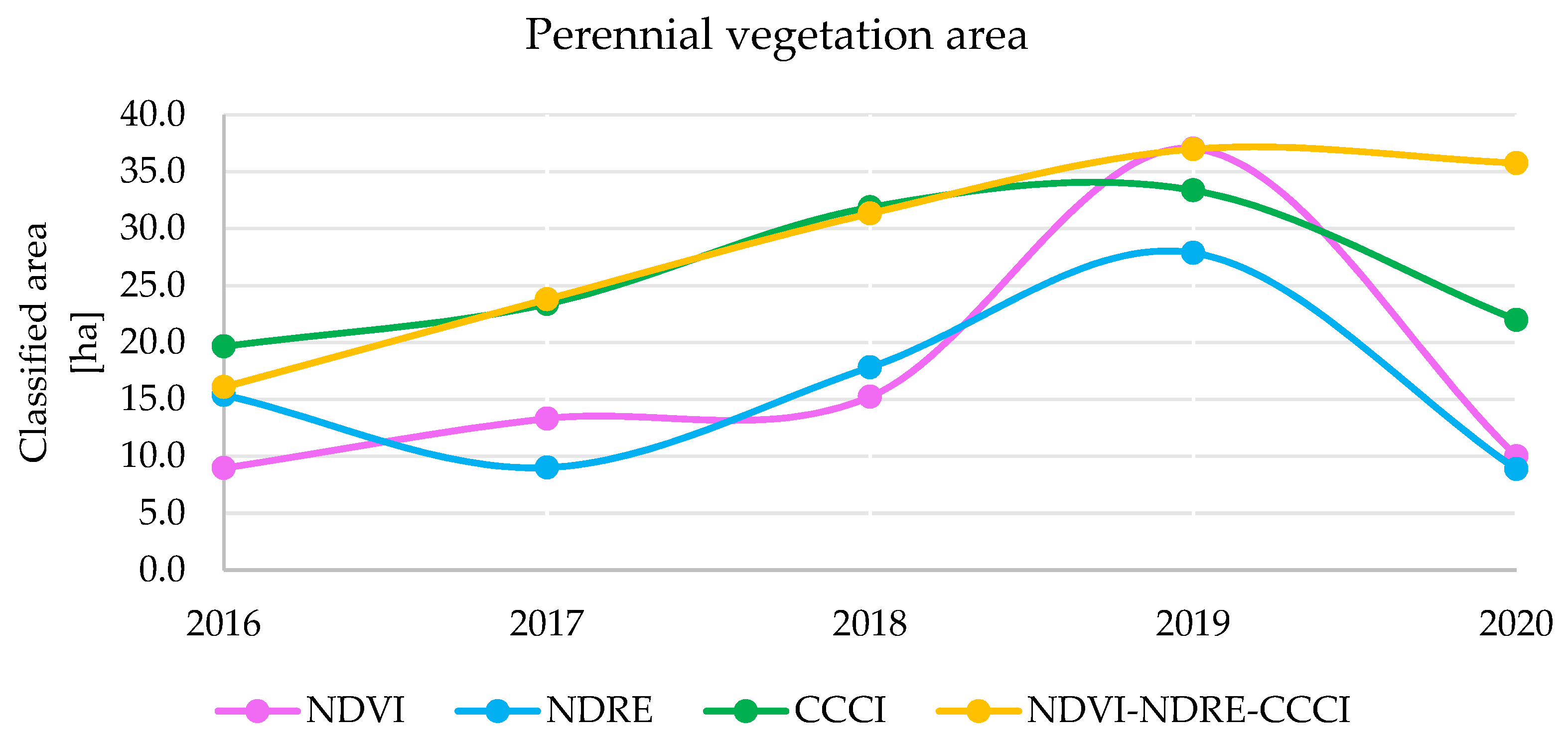
| First Dry Season | Long Rains Season | Second Dry Season | Short Rains Season | |
|---|---|---|---|---|
| 2016 | 14 February | 14 May | 21 September | 10 December |
| 2017 | 28 February | 19 May | 27 August | 20 November |
| 2018 | 13 February | 4 May | 22 August | 25 December |
| 2019 | 30 March | 9 May | 27 August | 20 December |
| 2020 | 8 April | 13 May | 31 August | 24 November |
| Parameters | NDVI | NDRE | CCCI | NNC | Modal Aggregation |
|---|---|---|---|---|---|
| Overall accuracy | 0.95 | 0.93 | 0.90 | 0.94 | 0.94 |
| Producer’s accuracy (densely vegetated) | 0.92 | 0.84 | 0.77 | 0.88 | 0.85 |
| User’s accuracy (densely vegetated) | 0.91 | 0.93 | 0.88 | 0.92 | 0.94 |
| Producer’s accuracy (not densely vegetated) | 0.96 | 0.97 | 0.95 | 0.97 | 0.98 |
| User’s accuracy (not densely vegetated) | 0.97 | 0.93 | 0.91 | 0.95 | 0.94 |
| Kappa coefficient | 0.95 | 0.82 | 0.75 | 0.86 | 0.85 |
Publisher’s Note: MDPI stays neutral with regard to jurisdictional claims in published maps and institutional affiliations. |
© 2021 by the authors. Licensee MDPI, Basel, Switzerland. This article is an open access article distributed under the terms and conditions of the Creative Commons Attribution (CC BY) license (https://creativecommons.org/licenses/by/4.0/).
Share and Cite
Bigi, V.; Vigna, I.; Pezzoli, A.; Comino, E. Multi-Temporal Evaluation of Quantitative and Phenological Vegetation Dynamics Using Sentinel-2 Images in North Horr (Kenya). Sustainability 2021, 13, 13554. https://doi.org/10.3390/su132413554
Bigi V, Vigna I, Pezzoli A, Comino E. Multi-Temporal Evaluation of Quantitative and Phenological Vegetation Dynamics Using Sentinel-2 Images in North Horr (Kenya). Sustainability. 2021; 13(24):13554. https://doi.org/10.3390/su132413554
Chicago/Turabian StyleBigi, Velia, Ingrid Vigna, Alessandro Pezzoli, and Elena Comino. 2021. "Multi-Temporal Evaluation of Quantitative and Phenological Vegetation Dynamics Using Sentinel-2 Images in North Horr (Kenya)" Sustainability 13, no. 24: 13554. https://doi.org/10.3390/su132413554
APA StyleBigi, V., Vigna, I., Pezzoli, A., & Comino, E. (2021). Multi-Temporal Evaluation of Quantitative and Phenological Vegetation Dynamics Using Sentinel-2 Images in North Horr (Kenya). Sustainability, 13(24), 13554. https://doi.org/10.3390/su132413554







